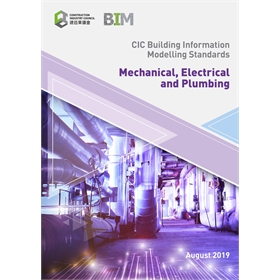Resources
Download List: 0 items
Publications

CIC Production of BIM Object Guide - General Requirements (August 2019)
This Guide is the updated version of the CIC Production of BIM Object Guide - General Requirements published in June 2018. This updated version aims to enhance the images of samples and elaborate more details of the previous one to provide the BIM practitioners with a good practice and guidance for the production of BIM Object. About Classification (classification system), the OmniClass Table 23 is recommended (and note that version 2012 should be used, instead of version 2006) if there are no other specific requirements from the project Appointing Party / Client. For Revit users, they need to update the OmniClass version in Revit from 2006 to 2012, procedure can be found from this link: https://help.autodesk.com/view/RVT/2021/ENU/?guid=GUID-BA0B2713-ADA0-4E51-A7CD-85D85511F3ED Descriptions and Guidelines for the BIM Object Naming Fields: - - - - . In addition with the latest requirement of the CIC Production of BIM Object Guide General Requirements, maximum 30 characters for the entire name, including delimiters but excluding the file extension, following principles are set: No. Fields Mandatory or Optional Field Length Guidelines 1 Category Mandatory 3 These two fields shall follow the Master Type List of FLIP (Family Library Interchange Program). Please highlight items that are not following FLIP, for CIC's confirm. 2 Functional Type Mandatory 3 3 Originator Mandatory 3 For BIM objects originating from Work Departments, corresponding department names should be used as originator names. However, other consultant or contractors who create the new BIM objects should follow Agent Responsible Code (ARC) list for originator. For those consultant or contractors, this field shall follow the up-to-date version of the ARC published by DEVB under the CAD Standard for Works Projects. ARC full list can be referred to this link: https://www.devb.gov.hk/filemanager/en/content_203/arc v3.06.00.pdf). If a BIM object is fully adopted without change, its name should be maintained. However, if the BIM object is modified, its originator code should be updated and saved as another BIM object. 4 Descriptor 1 Optional 1-15 Descriptor 1 contains information about primary use and material when applicable. a. Duplicate information with the Category and Functional Type should be avoided. For example, if category is “WDW” (means window), “window” should not be used in this field. If functional type is “DBL” (means double), then “double” should not be used in this field. b. Capital letters should be used for first letter of each word (e.g. WallMounted, GlobalValve). c. All-capital short forms should be used to indicate materials when applicable (e.g. CONC for concrete, WD for Wood). If Descriptor 1 starts with all-capital short form, an underscore (_) should be used to separate the short form and the following word (e.g. CONC_Kerb, WD_Slash). d. If Descriptor 1 is blank, three nos. of underscores (___) should be used in place of Descriptor 1 (e.g. SFM-RCB-ACM-___-01.rfa). e. Descriptor 1 should be kept as concise as practicable with the maximum length of 15 characters in order to reserve space for 2 digit sequential number in Descriptor 2 for potential future expansion. 5 Descriptor 2 Optional 2 Descriptor 2 is a 2-digit sequential number (e.g. 01 to 99) to distinguish different types that cannot be sufficiently identified by preceding fields. (e.g. STE-STA-ACM-NB_Pier-01.rfa) If Descriptor 2 is blank, two underscores (__) should be used in place of Descriptor 2. (e.g. PPF-UPV-ACM-BendSocket-__.rfa)

CIC BIM Standards for Mechanical, Electrical and Plumbing (August 2019)
(The zip file contains the BIM Standards and the LOD Responsibility Matrix) This document sets out the BIM Standards for Mechanical, Electrical and Plumbing (MEP) and it should also be read in conjunction with the CIC BIM Standards – General. The appropriate Level of Development (LOD) for adoption of a BIM Standards is a controversial topic, especially in the MEP discipline. It is necessary to define a standard and align the industry with a consistent and mutual understanding, to avoid causing misunderstanding and ambiguities among clients and project teams that may lead to additional effort, time and cost. This BIM Standards is focused on LOD which is software neutral. The LOD framework and approach set out in this BIM Standards apply to the MEP discipline.

